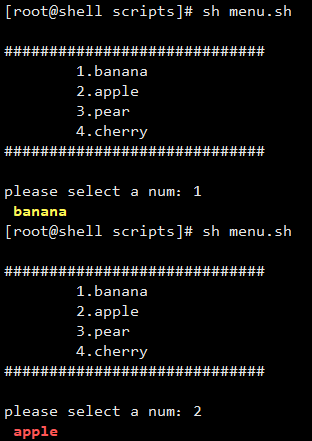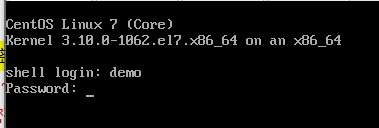shell脚本中的case条件语句介绍和使用案例
- 2020 年 4 月 2 日
- 筆記
#前言:这篇我们接着写shell的另外一个条件语句case,上篇讲解了if条件语句。case条件语句我们常用于实现系统服务启动脚本等场景,case条件语句也相当于if条件语句多分支结构,多个选择,case看起来更规范和易读
#case条件语句的语法格式
case "变量" in 值1) 指令1... ;; 值2) 指令2... ;; *) 指令3... esac
#说明:当变量的值等于1时,那么就会相应的执行指令1的相关命令输出,值等于2时就执行指令2的命令,以此类推,如果都不符合的话,则执行*后面的指令,要注意内容的缩进距离
#简单记忆
case "找工作条件" in 给的钱多) 给你工作... ;; 给股份) 给你工作... ;; 有发展前景) 可以试试... ;; *) bye bye !! esac
#实践使用
实践1.根据用户的输入判断用户输入的是哪个数字,执行相应动作
#如果用户输入的是1-9的任意一个数字,则输出对应输入的数字,如果是别的字符,则提示输出不正确并退出程序
[root@shell scripts]# cat num.sh #!/bin/bash #create by guoke #function number input read -p "please input a number:" num #打印信息提示用户输入,输入信息赋值给num变量 case "$num" in 1) echo "The num you input is 1" ;; [2-5]) echo "The num you input is 2-5" ;; [6-9]) echo "The num you input is 6-9" ;; *) echo "please input number[1-9] int" exit; esac
#说明:使用read读取用户输入的数据,然后使用case条件语句进行判断,根据用户输入的值执行相关的操作
#执行效果
[root@shell scripts]# sh num.sh please input a number:1 The num you input is 1 [root@shell scripts]# sh num.sh please input a number:3 The num you input is 2-5 [root@shell scripts]# sh num.sh please input a number:4 The num you input is 2-5 [root@shell scripts]# sh num.sh please input a number:8 The num you input is 6-9 [root@shell scripts]# sh num.sh please input a number:a please input number[1-9] int
实践2.打印一个如下的水果菜单
(1) banana
(2) apple
(3) orange
(4) cherry
#脚本编写
[root@shell scripts]# cat menu.sh #!/bin/bash #create by guoke #function print menu RED_COLOR='E[1;31m' GREEN_COLOR='E[1;32m' YELLOW_COLOR='E[1;33m' BLUE_COLOR='E[1;34m' RES='E[0m' echo ' #使用echo打印菜单 ############################# 1.banana 2.apple 3.pear 4.cherry ############################# ' read -p "please select a num:" num case "$num" in 1) echo -e "${YELLOW_COLOR} banana ${RES}" ;; 2) echo -e "${RED_COLOR} apple ${RES}" ;; 3) echo -e "${GREEN_COLOR} pear ${RES}" ;; 4) echo -e "${BLUE_COLOR} cherry ${RES}" ;; *) echo "please input {1|2|3|4}" esac
#说明:定义颜色,使用read读取用户输入的数据,然后使用case条件语句进行判断,根据用户输入的值执行相关的操作,给用户输入的水果添加颜色
#扩展:输出菜单的另外种方式
cat<<-EOF =============================== 1.banana 2.apple 3.pear 4.cherry =============================== EOF
#执行效果
#如果输入不正确或者不输入的话就打印帮助
[root@shell scripts]# sh menu.sh ############################# 1.banana 2.apple 3.pear 4.cherry ############################# please select a num: please input {1|2|3|4}
#输入选项中的数字,打印相关信息

实践3.开发nginx启动脚本
#主要思路:
#1.主要通过判断nginx的pid文件有无存在,通过返回值查看有没有运行
#2.通过case语句获取参数进行判断
#3.引入系统函数库functions中的action函数
#4.对函数及命令运行的返回值进行处理
#5.设置开机自启动
#附上nginx编译安装过程
#!/bin/bash yum install gcc pcre pcre-devel wget openssl openssl-devel.x86_64 -y mkdir -p /home/demo/tools cd /home/demo/tools/ wget -q http://nginx.org/download/nginx-1.6.3.tar.gz useradd nginx -s /sbin/nologin -M tar xf nginx-1.6.3.tar.gz cd nginx-1.6.3/ ./configure --user=nginx --group=nginx --prefix=/application/nginx --with-http_stub_status_module --with-http_ssl_module make make install ln -s /application/nginx-1.6.3 /application/nginx/ #做软连接 /application/nginx/sbin/nginx -t #检查语法 /application/nginx/sbin/nginx #启动服务
#脚本编写
[root@shell init.d]# chmod +x /etc/init.d/nginxd [root@shell init.d]# cat nginxd #!/bin/bash
#chkconfig: 2345 40 98 #设定2345级别,开机第40位启动脚本,关机第98位关闭脚本 #create by guoke #email:1075792988@qq.com #function nginx start scripts [ -f /etc/init.d/functions ] && source /etc/init.d/functions #引入系统函数库 PIDFILE=/application/nginx/logs/nginx.pid #定义PID文件路径 NGINX=/application/nginx/sbin/nginx #定义启动命令路径 value(){ #定义返回值函数 RETVAL=$? if [ $RETVAL -eq 0 ];then action "Nginx is $1" /bin/true else action "Nginx is $1" /bin/true fi } start(){ #定义启动函数 if [ -f $PIDFILE ];then #判断PIDFILE存不存在,存在就打印运行,否则就启动 echo "Nginx is running" else $NGINX value start #调用返回值函数 fi } stop(){ #定义停止函数 if [ ! -f $PIDFILE ];then #也是通过判断PID文件是否存在然后进行相关操作 echo "Nginx not running" else $NGINX -s stop value stop fi } reload(){ #定义重启函数 if [ ! -f $PIDFILE ];then echo "not open $PIDFILE no such directory" else $nginx -s reload value reload fi } case "$1" in #使用case接收脚本传参的字符串 start) #如果第一个参数为start,调用start函数 start ;; stop) #如果第一个参数为stop,调用stop函数 stop ;; reload) stop sleep 1 start ;; *) echo "USAGE:$0 {stop|start|reload}" exit 1 esac
#执行效果
[root@shell init.d]# sh nginx stop Nginx is stop [ OK ] [root@shell init.d]# sh nginx start Nginx is start [ OK ] [root@shell init.d]# sh nginx reload Nginx is stop [ OK ] Nginx is start [ OK ]
实践4.开发跳板机
#要求用户登录到跳板机后只能执行管理员给定的选项动作,不能中断脚本而到跳板机服务器上执行任何系统命令
#思路
1.首先做好ssh key验证登录 2.实现远程连接菜单选择脚本 3.利用Linux信号防止用户在跳板机上操作 4.用户登录后就调用脚本
#操作过程
3.1.做ssh免密钥登录,发送到各个主机,如果机器多的话可以使用脚本进行循环发送
[demo@shell ~]$ ssh-keygen -t dsa -P "" -f ~/.ssh/id_dsa Generating public/private dsa key pair. Enter file in which to save the key (/home/demo/.ssh/id_dsa): Created directory '/home/demo/.ssh'. Your identification has been saved in /home/demo/.ssh/id_dsa. Your public key has been saved in /home/demo/.ssh/id_dsa.pub. The key fingerprint is: SHA256:BTFfcC2hMKBzuZeUYylC3qgza7z4X6j3RBlwq8Beoak demo@shell The key's randomart image is: +---[DSA 1024]----+ | + o.*...+o | | . = B o O +. . | | = B B * + . | | o + = B + | |E = . + S | | . + o . | | + . o | | o o.o | |..+o... | +----[SHA256]-----+ #命令说明:一键生成密钥,不用按回车。-t:指定要创建的密钥类型,-P:提供旧密码,空表示不需要密码,-f:指定位置
#将公钥拷贝到其他服务器的demo用户 [demo@shell ~]$ ssh-copy-id -i .ssh/id_dsa.pub "demo@192.168.86.129" [demo@shell ~]$ ssh-copy-id -i .ssh/id_dsa.pub "demo@192.168.86.130" [demo@shell ~]$ ssh-copy-id -i .ssh/id_dsa.pub "demo@192.168.86.131"
#3.2.编写脚本
[root@shell scripts]# cat tiaobanji.sh #!/bin/bash trapper(){ #定义屏蔽信号函数 trap '' INT QUIT TSTP TERM HUB } menu(){ #定义菜单列表函数 cat<<-EOF #加-后面的EOF就可以不用顶格 ==============Host List============== 1) 192.168.86.129 2) 192.168.86.130 3) 192.168.86.131 4) 192.168.86.132 5) exit ===================================== EOF } USER=demo host(){ #定义主机列表函数 case "$1" in 1) ssh $USER@192.168.86.129 ;; 2) ssh $USER@192.168.86.130 ;; 3) ssh $USER@192.168.86.131 ;; 4) ssh $USER@192.168.86.132 ;; 5) exit esac } main(){ #定义主函数 while : #while循环,一直循环 do trapper #调用trapper函数 clear #清屏 menu #调用菜单函数 read -p "please select a num:" num #获取用户输入 host $num #调用主机列表函数和传入的参数,进行远程登录 done } main #调用主函数
#3.3.编写脚本进行判断,判断是否是root用户登录,如果不是root用户就执行脚本,弹出跳板机界面
[root@shell ~]# cd /etc/profile.d/ [root@shell profile.d]# cat jump.sh #!/bin/bash [ $UID -ne 0 ] && . /scripts/tiaobanji.sh
#3.4.测试
#登录demo普通用户输入密码的时候就会直接跳到选项卡页面了

#选项卡页面
==============Host List============== 1) 192.168.86.129 2) 192.168.86.130 3) 192.168.86.131 4) 192.168.86.132 5) exit ===================================== please select a num:1 #进行选择 Last login: Tue Mar 31 23:48:33 2020 from 192.168.86.128 [demo@mysql ~]$
#3.5.提示:跳板机的安全
1.禁止跳板机可以从外网IP进行登录,只能从内网IP登录 2.其他服务器也限制只能内网IP登录,同时禁止root登录,做完ssh key认证,将密码登录禁止,通过免密码登录到其他服务器
#总结:if条件语句主要用于取值判断、比较,应用比较广,case条件语句只要是写服务的启动脚本,各有各的优势。好了,shell脚本的条件语句就讲解到这里了,接下来会继续写shell脚本的循环(包括for,while等),如果写的不好的地方还望指出,多多交流提高,下次再会。。。

